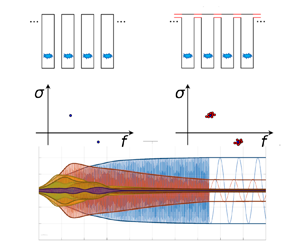Published online by Cambridge University Press: 16 February 2024

Can-annular combustors feature clusters of thermoacoustic eigenvalues, which originate from the weak acoustic coupling between  $N$ identical cans at the downstream end. When instabilities occur, one needs to consider the nonlinear interaction between all
$N$ identical cans at the downstream end. When instabilities occur, one needs to consider the nonlinear interaction between all  $N$ modes in the unstable cluster in order to predict the steady-state behaviour. A nonlinear reduced-order model for the analysis of this phenomenon is developed, based on the balance equations for acoustic mass, momentum and energy. Its linearisation yields explicit expressions for the
$N$ modes in the unstable cluster in order to predict the steady-state behaviour. A nonlinear reduced-order model for the analysis of this phenomenon is developed, based on the balance equations for acoustic mass, momentum and energy. Its linearisation yields explicit expressions for the  $N$ complex-valued eigenfrequencies that form a cluster. To treat the nonlinear equations semianalytically, a Galerkin projection is performed, resulting in a nonlinear system of
$N$ complex-valued eigenfrequencies that form a cluster. To treat the nonlinear equations semianalytically, a Galerkin projection is performed, resulting in a nonlinear system of  $N$ coupled oscillators. Each oscillator represents the dynamics of a global mode that oscillates in the whole can-annular combustor. The analytical expressions of the equations reveal how the geometrical and thermofluid parameters affect the thermoacoustic response of the system. To gain further insights, the method of averaging is applied to obtain equations for the slow-time dynamics of the amplitude and phase of each mode. The averaged system, whose solutions compare very well with those of the full oscillator equations, is shown to be able to predict complex transient dynamics. A variety of dynamical states are identified in the steady-state oscillatory regime, including push–push (in-phase) and spinning oscillations. Notably, the averaged equations are able to predict the existence of synchronised states. These states occur when the frequencies of two (or more) unstable modes with nominally different frequencies lock onto a common frequency as a result of nonlinear interactions.
$N$ coupled oscillators. Each oscillator represents the dynamics of a global mode that oscillates in the whole can-annular combustor. The analytical expressions of the equations reveal how the geometrical and thermofluid parameters affect the thermoacoustic response of the system. To gain further insights, the method of averaging is applied to obtain equations for the slow-time dynamics of the amplitude and phase of each mode. The averaged system, whose solutions compare very well with those of the full oscillator equations, is shown to be able to predict complex transient dynamics. A variety of dynamical states are identified in the steady-state oscillatory regime, including push–push (in-phase) and spinning oscillations. Notably, the averaged equations are able to predict the existence of synchronised states. These states occur when the frequencies of two (or more) unstable modes with nominally different frequencies lock onto a common frequency as a result of nonlinear interactions.